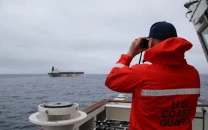Greenland Landslide Shaked Earth for Nine Days, Scientists baffled
Seismic waves from Greenland’s landslide were detected from the Arctic to Antarctica.
1726399545-0/Untitled-design-(5)1726399545-0-640x480.webp)
In September 2023, a massive landslide in Greenland's remote Dickson Fjord caused the Earth to tremble for an unprecedented nine days, generating seismic signals detected worldwide. The landslide, triggered by climate change, resulted in a colossal tsunami that sent vibrations travelling from the Arctic to Antarctica.
Global Seismic Puzzle
Seismometers recorded unusual, persistent vibrations during the event, which were distinct from typical earthquake signals. These vibrations, noted for their single frequency resembling a monotonous hum, puzzled scientists. Dr Stephen Hicks from University College London’s Earth Sciences department remarked, “When I first saw the seismic signal, I was completely baffled.”
Massive Landslide and Tsunami
The landslide saw a 1.2-kilometre-high mountain peak collapse into the fjord, with an estimated 25 million cubic metres of rock and ice creating a 110-metre-high wave. The tsunami's impact was dramatic but short-lived, with the wave height reducing to 7 metres within minutes. The subsequent water sloshing in the fjord generated the global seismic signal that scientists have since studied.
Scientific Investigation
An international team of 68 researchers from 40 institutions in 15 countries investigated the phenomenon. Using computer modelling, satellite imagery, and field measurements, they recreated the landslide and tsunami events. Their model accurately predicted the global vibrations, which lasted for nine days, reflecting the immense scale of the disaster.
Climate Change Implications
The landslide was attributed to glacier thinning due to climate change, which destabilised the mountain. Dr Kristian Svennevig, lead author from the Geological Survey of Denmark and Greenland, highlighted the significance of the study: “This is the first-ever landslide and tsunami observed from eastern Greenland, showing how climate change has major impacts there.”
Need for Monitoring
The study underscores the urgent need to monitor polar regions as climate change increases the likelihood of large-scale landslides. With the Arctic warming nearly four times faster than the global average, the study advocates for enhanced surveillance to provide early warnings for such catastrophic events.



















COMMENTS
Comments are moderated and generally will be posted if they are on-topic and not abusive.
For more information, please see our Comments FAQ